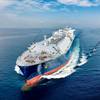No Sign of Ultra-Large Containership Mega Hubs: Analysis
Contrary to the views of some in the industry, Ultra Large Container Vessels are continuing to call at multiple North European ports per loop and are not concentrating on a mega-hub, according to Drewry’s latest Container Insight Weekly, excerpted here.
Despite containerships doubling in size in the past 10 years on the Far East-North Europe route, there has not been a reduction in the number of North European ports called by each service.
The average number of North European port calls per loop has remained broadly unchanged, at four per service string. As in the past, container services follow a traditional multi-port itinerary and call at about four separate North European ports. These are typically a Benelux port (usually Rotterdam or Antwerp), a German port, a UK port and either Le Havre or one of the second-tier European ports.
In fact, since 2009, shipping lines have also started calling at additional North European ports which they previously did not serve directly, such as Gdansk in Poland. Initially, this was partly driven by a desire to use up excess ship capacity by extending voyage times (in conjunction with slow steaming). However, it has not proved to be a short-lived move and now appears to be well established.
None of the major North European ports has become dominant or displaced competing ports. However, some second-tier ports (such as Amsterdam and Thamesport) have been forced out as ports of call on the Far East-North Europe route.
So, vessels calling at four North European ports has been a constant in the past 10 years and there is no sign at all of a move to a single North European mega-hub.
This confirms the old shipping adage that the mothership must go as close as possible to the final destination or origin of the cargo – where the market is a large one. This is also advantageous for shippers, because direct calls avoid the risk of missed feeder connections.
But the port industry is seeing radical change in another area: the total number of North Europe port calls on the Far East-North Europe route has fallen from 159 to 101 in the past 5 years whereas the average ship size has increased by over 50%, reaching nearly 11,000 teu. Each vessel still calls at more or less the same number of North European ports, but there are fewer weekly services and therefore less frequent calls at ports overall, by much larger ships, with much larger container exchanges per call.
For example, in the first half of 2014, the port of Hamburg received 244 Ultra Large Container Vessels of more than 10,000 teu capacities, 27% more than a year earlier. But what are the factors behind the pattern of less frequent, bigger ships calling at the major traditional ports?
Scale economies on mothership costs (running fewer weekly services with bigger ships), the advent of larger alliances (less duplication of port calls) and the reduction in the number of carriers (exit of MISC, Zim and others from the trade) have all played a part. These factors will not go away and should see a continuation of the current structure and rotation patterns of Far East-North Europe services.
Drewry's View
Multi-port rotations will continue in North Europe, but there will be fewer, less frequent calls by increasingly large containerships. The peaking caused by this will continue to challenge many ports and terminals.
Source: Drewry Maritime Research – 'Container Insight Weekly'










